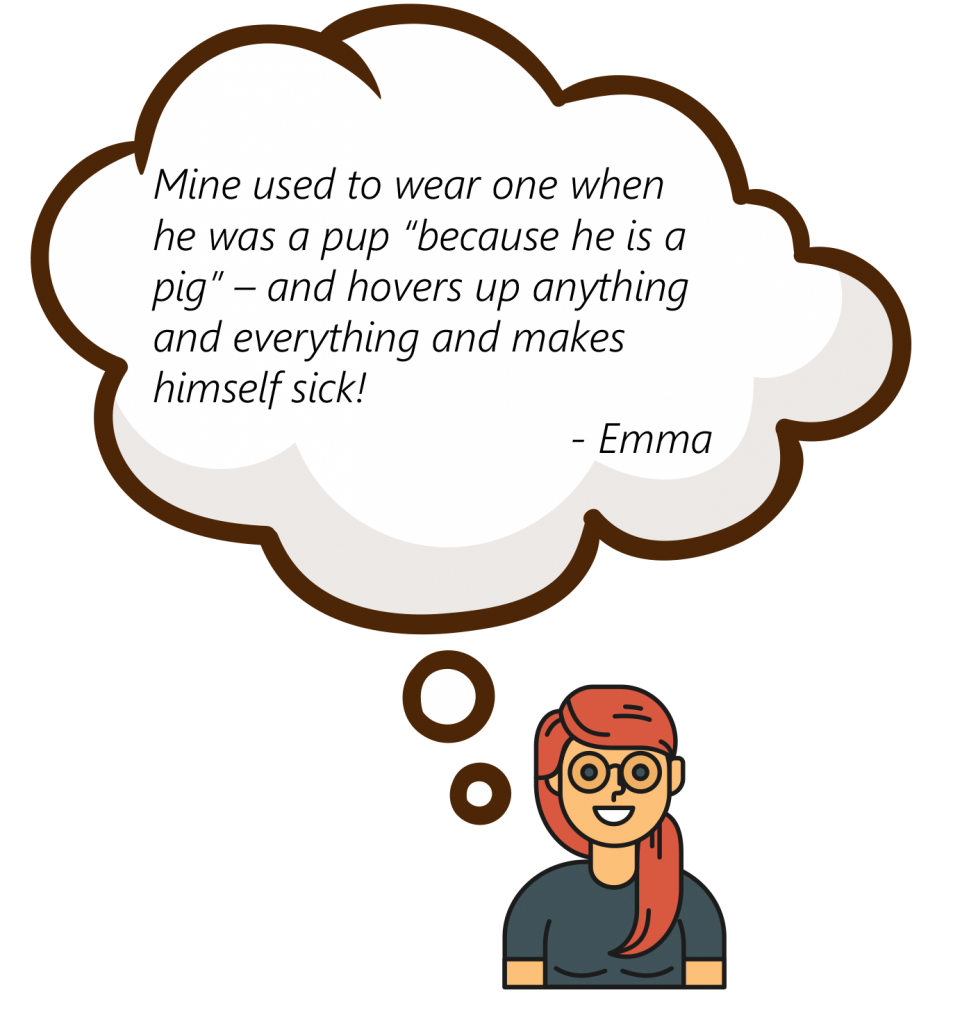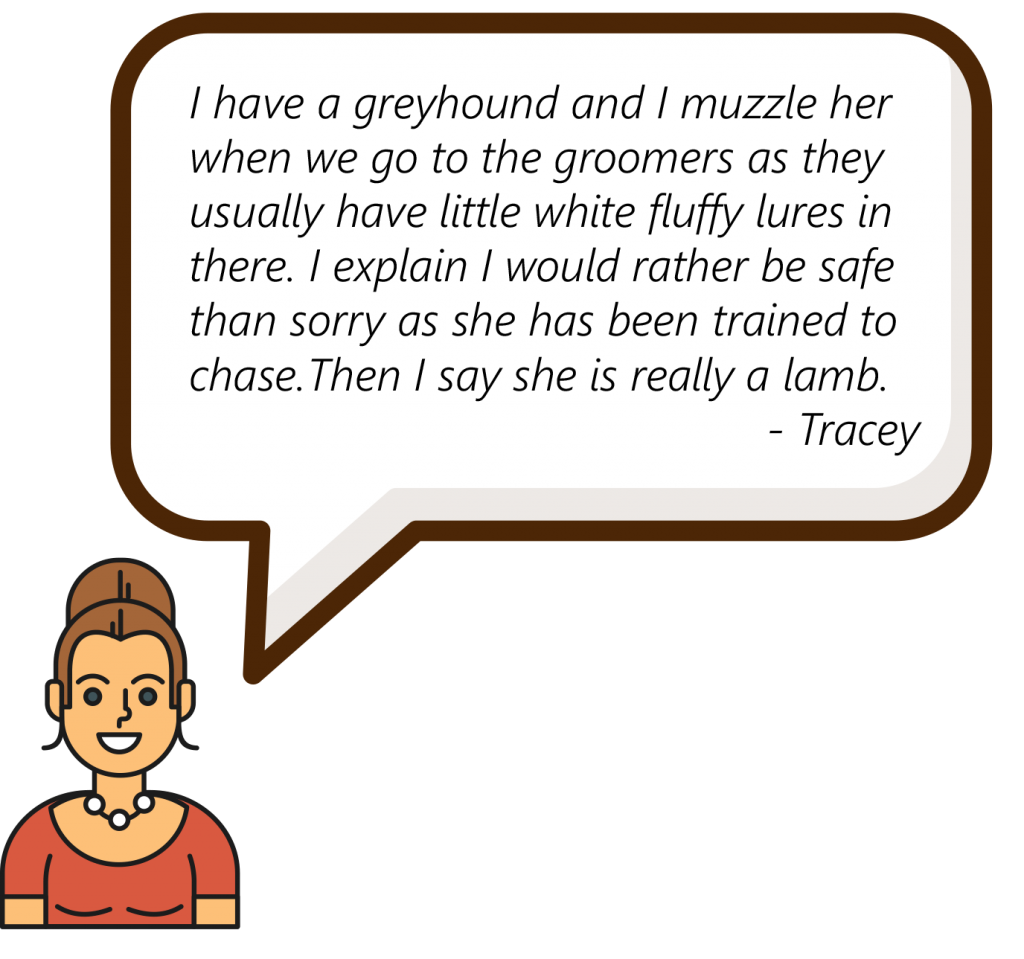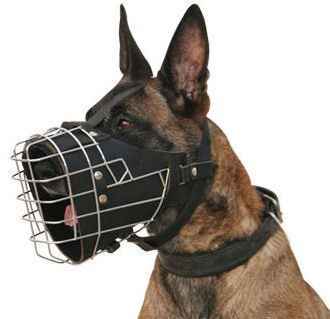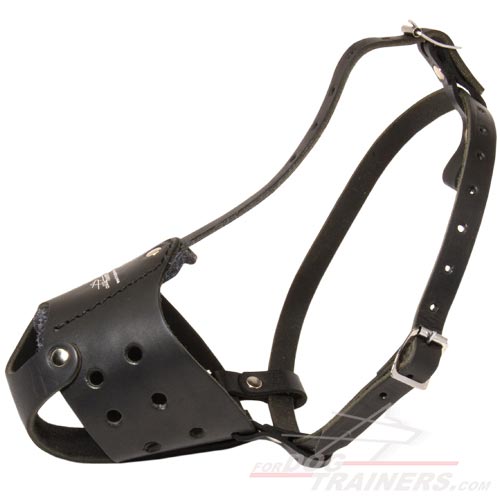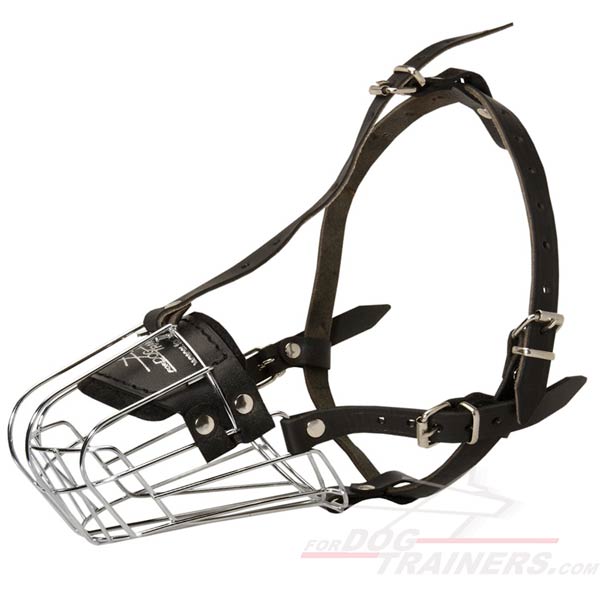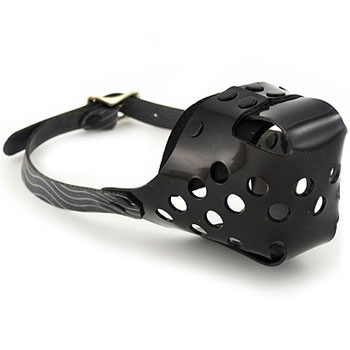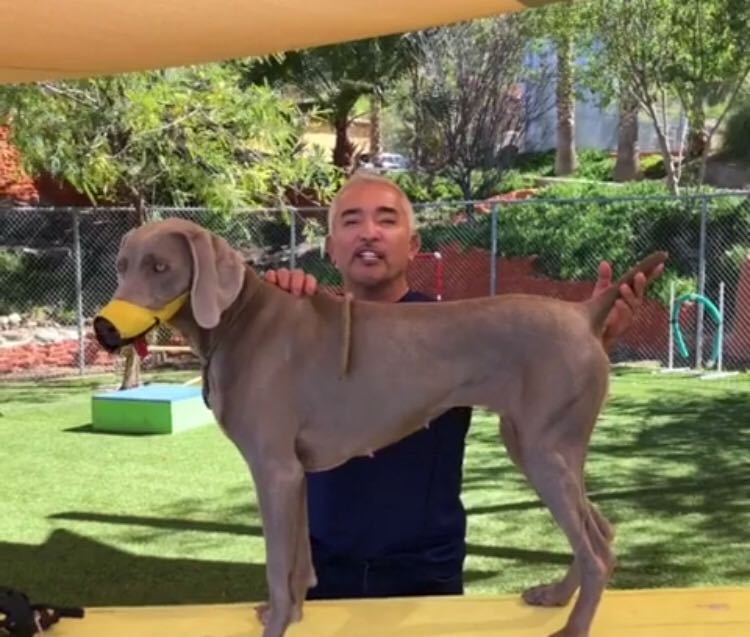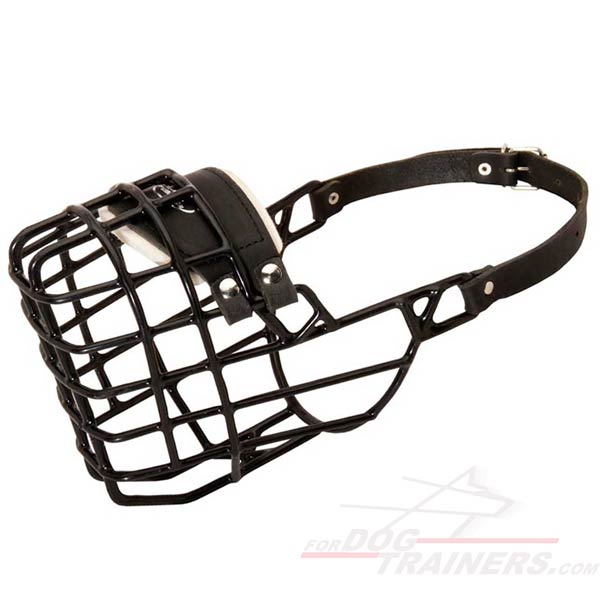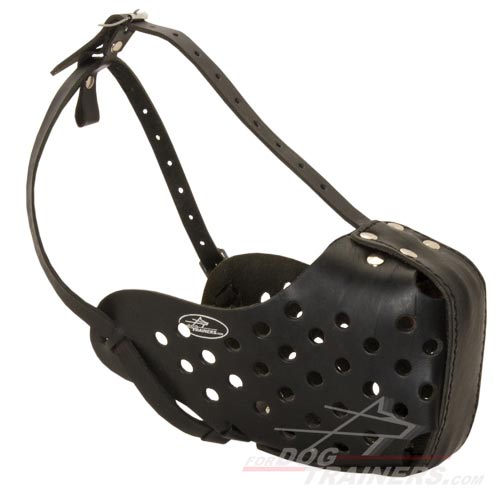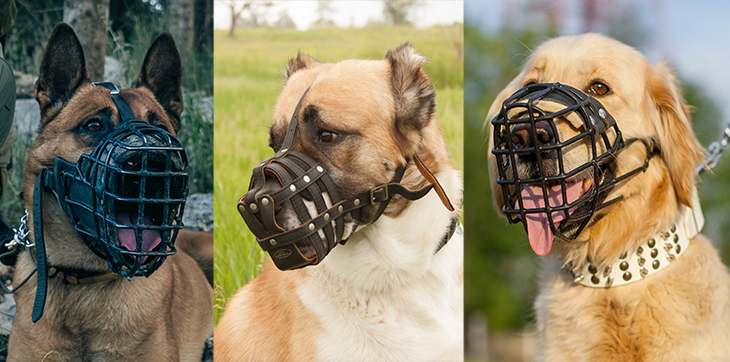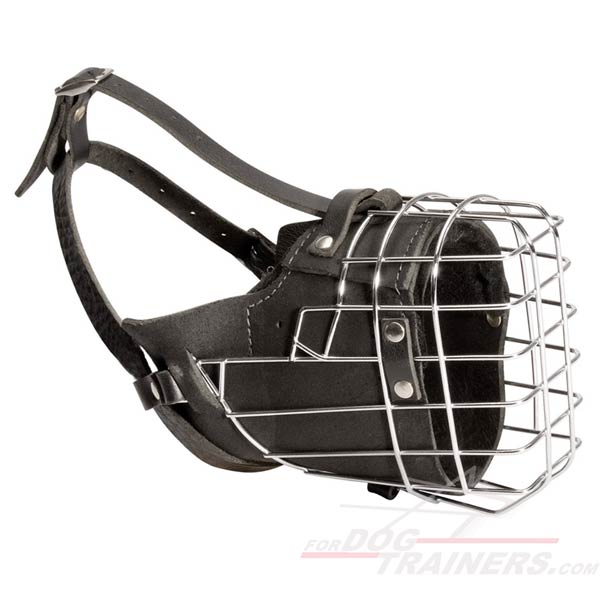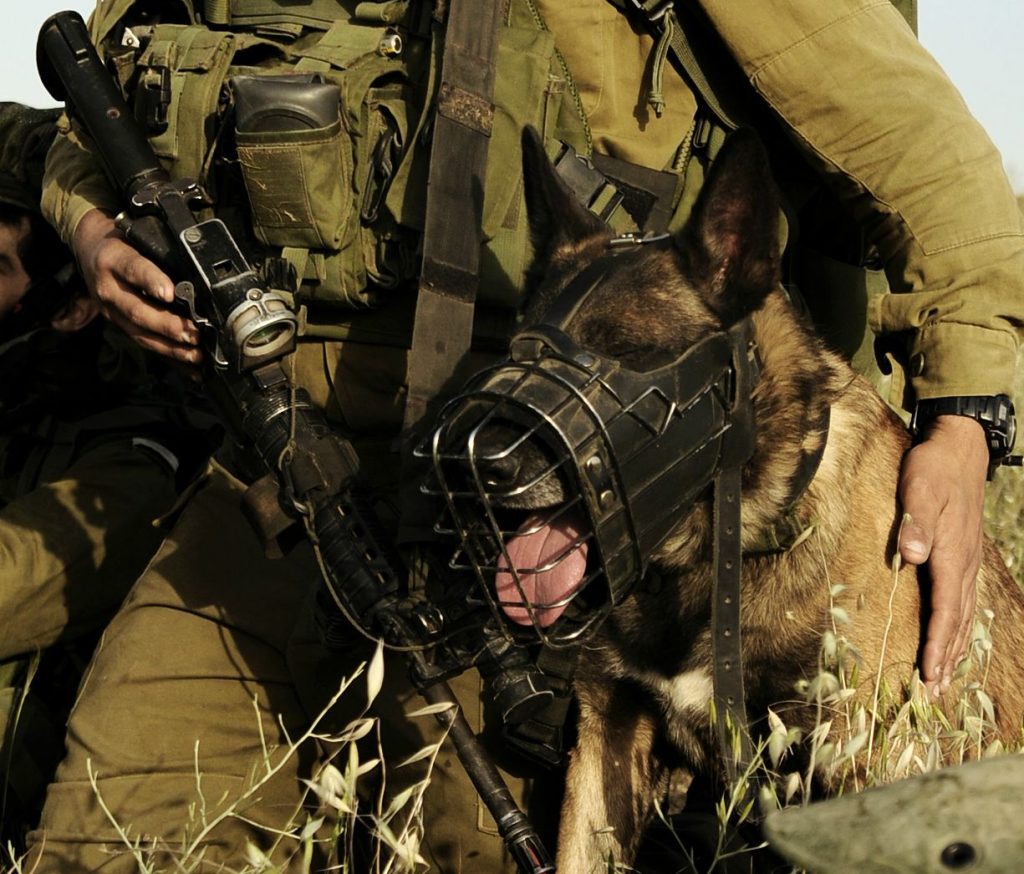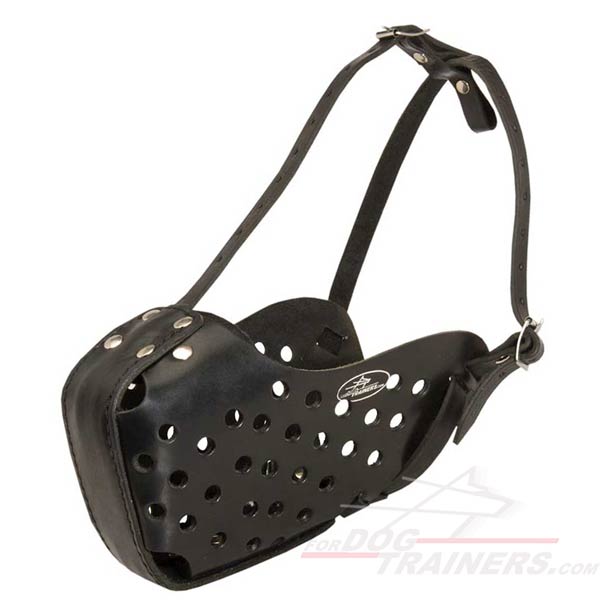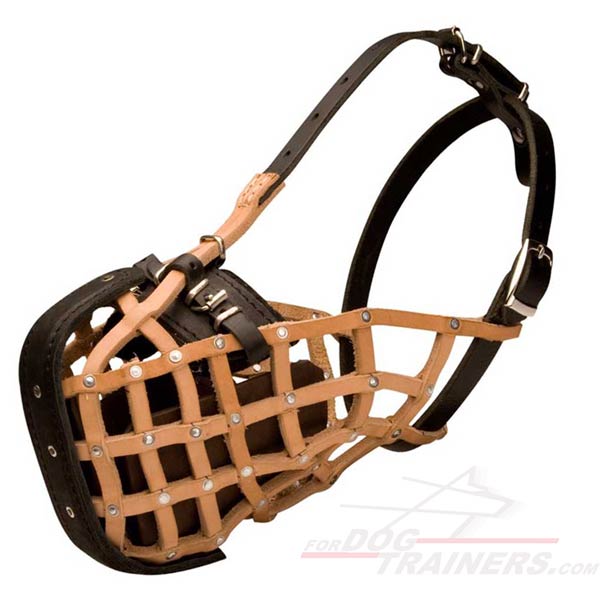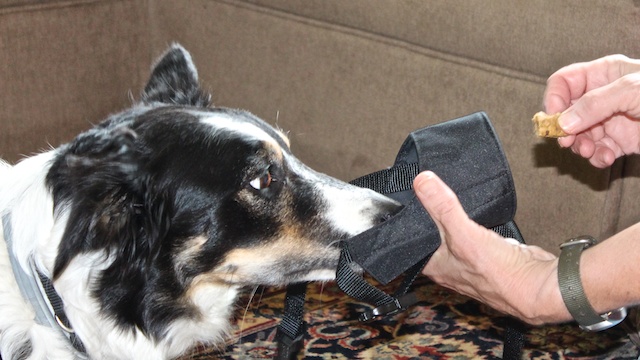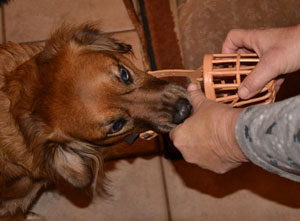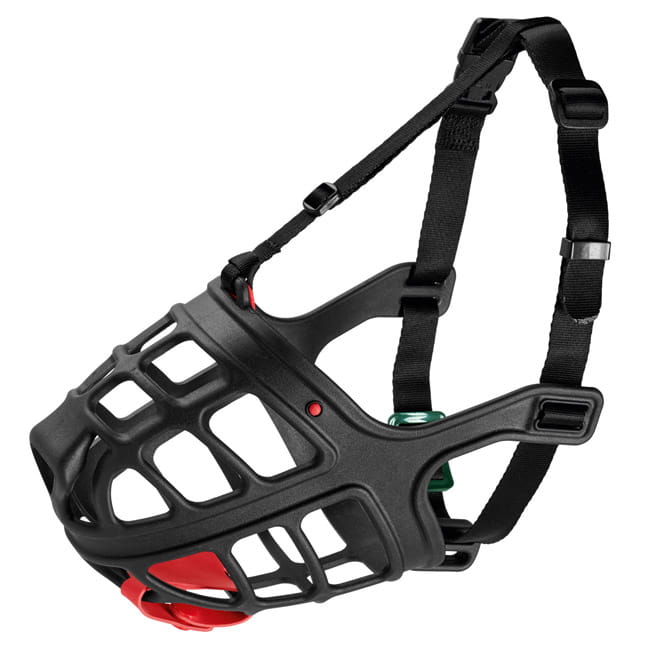Contents
Introduction
Are you a true dogman to the core?
Can’t imagine your life without your four-legged friend?
Is it the most kind and loyal creature in the world, and it doesn’t matter that its weight already reaches 40 kg?
Perfectly, you are the same dog-freak as me, but please look at the other side of the coin, as your dog isn’t so sweet and kind for strangers. Have you ever noticed fright or even fear on the faces of strangers passing by when walking your dog muzzled? I bet, you have! Even I was one of them. The first thing that comes to their mind is that your dog is really dangerous or even vicious. In reality, this is not always the case!
Frankly speaking, fear of the strangers outside isn’t the only reason why you should put a muzzle on your dog’s face. Of course, when I thought about it firstly, I was also of the same opinion and wanted to buy a muzzle for my hound to comfort old ladies from the neighboring courtyard. Yes, I wasn’t so clever in this question at the beginning, but when I dig dipper, I discovered that:
Primarily, it’s law requirements.
Deciding to become a dog-owner or to go abroad with your pet, first of all you should consult concerning the dog legislation in a certain country. Dog bans and restrictions differ from country to country. There are some dog breeds that are prohibited entirely, but for the most part, there are only some requirements such as muzzling and walking your dog on a short leash in public.
The next thing is your four-pawed friend`s safety.
Walking your dog is extremely important to his/her health as well as vaccination and proper nutrition. But you can often notice that your dog can pick up some uneatable items, such as pieces of plastic, paper or even feces. A muzzle is a good tool on the way of preventing these bad habits.
Yes, it is probably the most evident reason why your dog should be muzzled during walks in the park. But there are some more, and I guess you want to know them all, but let’s talk about it a little later.
The third thing is safety of other people.
It’s better safe than sorry. A muzzle serves as a means of protection from barking and biting people or even other animals in a case when a dog becomes nervous and uncontrollable.
Obviously, it’s better to prevent an awkward situation and just muzzle your dog, even if he/ she is just a goody-goody.
So, my dear friends, if you have enough time and desire, let’s learn all these aspects detailed. It’s just a few words at the beginning and I really hope you’ll find some time for reading the whole article. I would advise you to read it not because I’m its author and I’d like to make some advertisement. No, guys, I don’t have star sickness.
I just think that this article is completely worth to be read, as it’s really one and only. All information given here is the result of really great work, please believe me: these are dozens of read articles and notes, watched videos and many years of experience.
After reading it you’ll understand why it is so important to muzzle your dog even if he or she is good-mannered and never bites, which muzzle is better for your French Bulldog or Sheepdog and what you should do before putting a muzzle on your four-legged friend. And I hope you’ll kindly remember me when you successfully solve the problem of choosing an appropriate muzzle for your dog.
I really believe that it will be a quite interesting, useful and needed article as here you can find the answers to the most popular questions: does a dog really need a muzzle, when you should put it on your dog, how long your dog can wear a muzzle and many others. And for this purpose you should not read dozen of articles and watch thousands videos as I’ve already done it for you. Here you have a brief summary instead of 1 000 articles. I’m sure it will save your time significantly. I really hope so.
CAN, MAY or MUST NOT travel with dogs?
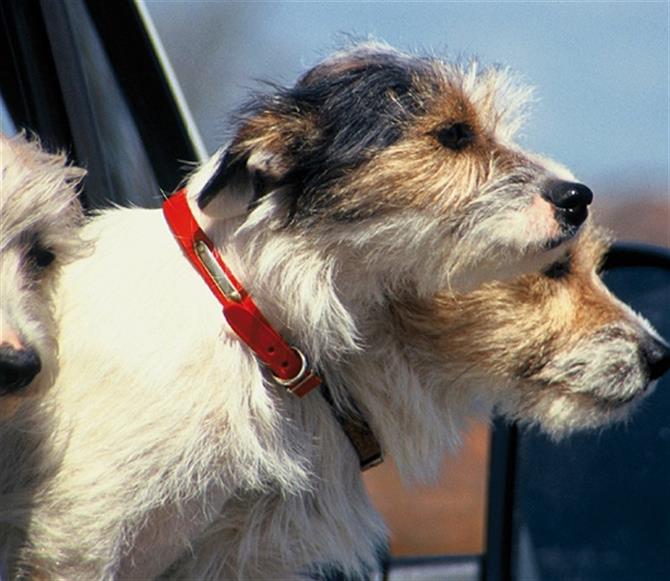 I won’t talk about legislation in your own city or state. Firstly, I am pretty sure that you know local muzzle dog laws perfectly. Secondly, I am not a psychic to read your mind and guess which city you live in. So don’t you mind us talking about laws in some unknown places?
I won’t talk about legislation in your own city or state. Firstly, I am pretty sure that you know local muzzle dog laws perfectly. Secondly, I am not a psychic to read your mind and guess which city you live in. So don’t you mind us talking about laws in some unknown places?
As a proverb says “If travelling was free, you would not see me again”. Yes, it’s the same about me, but I’d like to change it a little: “If I could travel with my dog, you would not see me again”. Yes, I’d like to travel at least every month to every new country, but unfortunately, it’s impossible.
 I want to tell you something. A bitter experience, dare I say. When I decided to make my first trip abroad with my dog, I faced with a lot of laws and restrictions. So, if you like traveling and can’t imagine it without your four-legged friend, please be informed that there are a lot of countries that have some restrictions concerning traveling with dogs. There are countries that have nothing against dogs-tourists, but others could be potentially dangerous for dogs to visit. Just imagine, 128 countries! So before packing a bag for your Brown or Browni, check out which country you can travel to.
I want to tell you something. A bitter experience, dare I say. When I decided to make my first trip abroad with my dog, I faced with a lot of laws and restrictions. So, if you like traveling and can’t imagine it without your four-legged friend, please be informed that there are a lot of countries that have some restrictions concerning traveling with dogs. There are countries that have nothing against dogs-tourists, but others could be potentially dangerous for dogs to visit. Just imagine, 128 countries! So before packing a bag for your Brown or Browni, check out which country you can travel to.
I won’t count now all the countries and forbidden and permitted breeds, sorry, dears, it’s impossible. But please take in your mind that dangerous dog breeds as Pitbull Terrier, Rottweilers, Bulldogs and their mixes are banned in most countries. So, if you have a dog of the breed I’ve mentioned before, please take attention to the restrictions applied to transportation of these pets, otherwise you voyage can finish before it even started.
I can say that the strictest dog laws are in the USA, Canada, New Zealand. Especially please be attentive if you visit the USA. Laws can differ from state to state, and one thing that is allowed in one state can be forbidden in another.
In Germany and Poland some breeds (from Akbash to Staffies to Dogos) must be muzzled in public, unless they have been evaluated for safety. But the law isn’t enforced and most people just ignore it. Dogs walk in parks, many off leash, some in pubs and buses, that would never be allowed in the USA.
So, my dear friends, now you are aware of the most important points that you should keep in mind concerning dog restrictions. And now again, but in a few words: please always muzzle your dog when you are going to visit some public places. And when you are going to travel to some places of interest in some far exotical (or not) countries, please check in advance if you may enter with your four-legged friend or must not. It will be pity if you are departed without visiting the Great Wall of China or Grand Canyon.
Muzzles for dogs: owners’ soul comfort or dogs’ safety
And now, my dears, let’s puzzle out in detail whether a dog needs a muzzle or it’s just for the owner’s soul comfort like following the instructions and laws?
There are different reasons why you should get a muzzle on your dog and not all of them are due to being aggressive. Here is the list of circumstances when a dog muzzle is especially useful:
| For owner | For dog |
| When introducing a dog to a public area. Meeting in public with other people and dogs, your four-legged friend can become nervous and aggressive, so better prevent possible bites and attacks and fit the muzzle before going to some public places. | When you are bringing home a new pet or a new baby. To avoid any chances that they may be put in danger, it would be best to fit a muzzle on your dog during the first few days or weeks after bringing newcomers to home. |
| When in the process of treating injured dogs or those experiencing pain. A dog who is being attended by emergency responders or even by his owner has the tendency to be defensive when he is in pain. An accidental pinching or grazing of a painful body part can definitely trigger a bite from a dog. So, a muzzle is better than bites. | When bringing home a new dog from a shelter. A dog taken from a shelter will have a background of abuse and neglect which can turn him into an angry and aggressive dog. The process of changing his behavior will take some time, so since you are not sure about the dog’s behavior, it would be important to put him on a muzzle not only to protect your family but your dog’s future as well. |
| When bringing your dog to the groomer or the vet’s office. Your dog can accept new people as strangers, and so he or she can act hostile toward them if they try to perform their work. So it’s quite better to muzzle your dog in advance. | When in public or crowded places your dog can suddenly change his behavior as the reaction for strangers, and he or she can try to bite someone and accidentally be dropped, or break a tooth. Try to avoid it in advance. |
| When the law requires it. This can be due to a past incident when your dog showed some aggression or it could be that you have a breed which your state requires to be put in a muzzle whenever they are in public. These are some breeds which are considered to be very dangerous such as Pit Bulls and Rottweilers. | Your dog doesn’t need a bad reputation and neither do you. Yes, it’s also the question of law requirements, but it refers more to a dog, rather than to an owner. If your dog has a history of biting, then you as an owner could possibly be charged with a misdemeanor, which could bring along with it jail time and a large fine. Further legal action could lead to a dog being muzzled whenever in public, or possibly even being forced to surrender or euthanize your pet. |
| Safety and health of your dog as some dogs engage in behaviors such as pica (eating inedible items, such as gravel or sticks) or coprophagia (eating feces) which could be dangerous to their health. While a muzzle may not entirely stop your dog from engaging in these behaviors, it can definitely slow him down and allow you the necessary time to intervene. Muzzles can also be helpful for scroungy dogs on special diets. |
(for more information, please, check the article “Best dog muzzle: how to choose a product for your dog’s needs“).
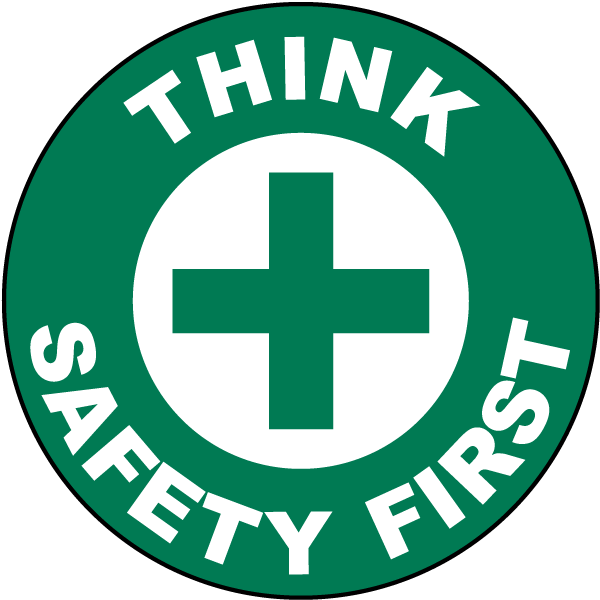 I’ve divided the most commonly known facts into these 2 columns. I’m sure you can find some interesting and similar issues in your common life as well, but please remember: even if you know your dog perfectly and have been cradled he or she for so many years, and if you always say: “My dog never bites!”, you can’t even suppose his/her behavior in an uncommon situation with strangers and other animals. Everything is possible even if you don’t think so. Please believe me and remember:
I’ve divided the most commonly known facts into these 2 columns. I’m sure you can find some interesting and similar issues in your common life as well, but please remember: even if you know your dog perfectly and have been cradled he or she for so many years, and if you always say: “My dog never bites!”, you can’t even suppose his/her behavior in an uncommon situation with strangers and other animals. Everything is possible even if you don’t think so. Please believe me and remember:
Safety is your primary concern. It must be #1 for you, your dog and strangers all around.
But at the same time, please take attention to the other side of the coin. These are such common and one-off points that can take place in real life, but please take them into account, as sometimes muzzling of your pet can give a quite opposite result:
- Putting a muzzle on your dog while acquainting him with little children or pet is a permanent solution. You should work with your dog to interact positively with children and other pets.
- If you put a muzzle on in unnecessary situations, that can make a dog more anxious and he/she may interpret a situation badly.
- A muzzled dog cannot defend himself in a conflict. If your dog is muzzled, tied up outside and a stray dog approaches, it could lead to a dog fight.
- Muzzling a dog can often make situations worse, if it is not truly needed. In the veterinary world they always say: “The less restraint, the better.” Dogs that are constantly muzzled for every little procedure, often develop a fear of the vet and become aggressive later on in life.
- Muzzles are often inappropriately used to discourage dogs from barking, chewing or eating and drinking during the night. A muzzle then becomes a form of punishment and results in a very negative reaction from your dog (for more information, please, check the article “What are the pros and cons of dog muzzles?“).
And one more interesting point: yes, sometimes I still face the opinion that only “bad” dogs wear muzzles, and if a dog is wearing a muzzle he or she must be a mean animal with horrible owners. But please remember that obedient dogs wear muzzles all the time, and there are many good reasons for teaching your dog to be happy and comfortable wearing a muzzle.
Is it really possible? – you can ask. And my reply is – Completely yes!
Let’s read what dogs parents write about it in blogs:


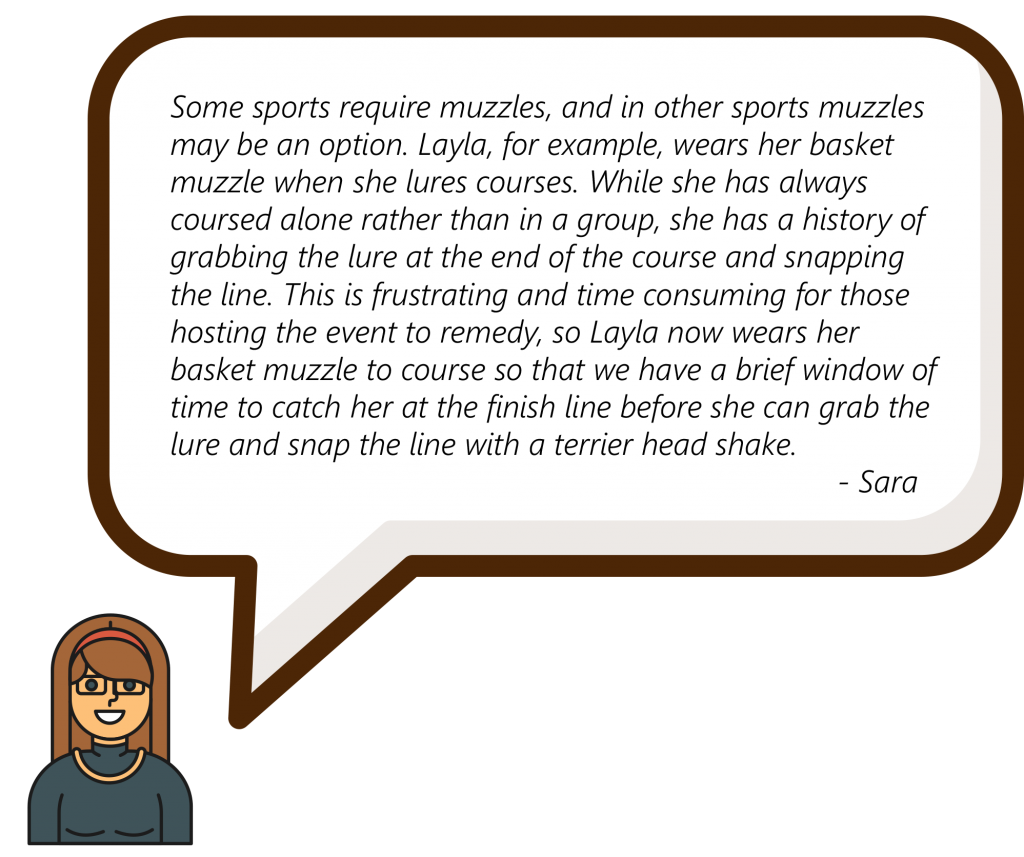
Also it can have a wonderful “bleed-over” effect, where the dog feels happier and safer wearing his muzzle because it’s always been associated with good things. The power of this emotional response can be incredible when introducing dogs into potentially stressful situations. Simply placing your dog’s muzzle on before a new situation may help to color that entire situation as safe and positive (for more information, please, check the article “Good dogs wear muzzles too“).
I hope, my dears, everything is quite easy and clear, and you can make your own conclusion. But please remember, that only an owner determines whether his dog needs or doesn’t need a muzzle. By and large, the owner has the right to influence the health and safety of his four-legged friend, people and animals around.
Muzzle for your dog: everything that you should know
So, my dear friends, we made it to the theoretical point of our conversation. Somebody can suppose it can be a little slow footed, but please, don’t be so prejudiced in advance and give me a chance. I’ll try to explain this mess of information in a plain language.
As I have already told you, a muzzle is not meant for aggressive dogs only. It is an integral part of training, socialization, visits to the vet, and for obeying the law as well. This is why a dog muzzle should never carry a stigma with it whenever a dog is seen wearing one!
When you choose a muzzle please keep in mind that the ideal choice is the one that:
- fits well,
- is lightweight, comfortable and durable,
- is secure enough to prevent your dog from removing it;
- is easy to clean,
- is easy to put on and easy (for an owner) to remove;
- prevents a dog from biting, yet allows the dog to breathe freely.
Just as any person needs his or her own size of cloth and shoes, dogs need their individual type and size of muzzles. Dogs come in all shapes and sizes and what works for a Greyhound is not going to work for a Staff. So, it seems quite obvious that before purchasing a muzzle for your pet you should check some criteria for choosing the proper one:
Size and fit considerations
While choosing the muzzle, please consider the following:
- Making sure the muzzle is not too small or too big is also difficult. If the muzzle is loose, or has lots of room, it will flop about and rub, your dog will feel uncomfortable with that or even worse – can be in pain. A muzzle that fits correctly will not affect your dog’s breathing or health in general.
- Most muzzle producers have guidelines for sizing the correct fit. However, if there is a store or outlet where you can take your friendly dog or puppy to be sized for the best fit, that is even better. If that is not enough, you can take measurements by yourself.
- To find the muzzle of the right size you should measure your dog from his/her eyes to the tip of his/her nose, and then measure the circumference of his/her face by measuring around his/her snout about an inch below his/her eyes. All you need for this is a fabric ruler.
I know it’s quite hard to understand how to measure you dog when you have never done it or seen anyone doing it. Let’s make it easy! Take a look at this picture! It shows completely clear what measures and in which way should be done.

Some muzzles have specific breed charts for each size. But please note, quite often they are given just as references you should start from.
If you need a more clear explanation in which way the measurements should be taken, please watch this video. Yes, for somebody it can be more useful, as it says better to see 1 time than 100 times to read.
But please check that there should be at least 1 to 1.5 cm of distance between the edge of a basket muzzle and your dog’s muzzle. The mouth should also be slightly open when measuring the height or circumference of the dog’s snout. The strap that attaches to the neck of your dog should also allow one finger to be inserted in between (for more information, please, check the article “Best dog muzzle: how to choose a product for your dog’s needs“).
Now, when all measurements are done and you finally got that strange device for your pet, how do you know that it fits well and does not disturb your pooch in any way?
When a muzzle fits properly, a dog is gets used to wearing one, and it allows the dog to pant easily, eat treats and even drink water through it. It is just another piece of equipment like a collar, harness, and leash. Oh..and most people that I see in my life say their dog will never wear a muzzle because their dogs hate them. In 99 percent of cases it is because they have not used the correct muzzle and/or have not acclimated the dog to wearing a muzzle correctly. Check the video of a dog wearing a muzzle after proper sizing and training.
https://www.facebook.com/FetchTheFacts/videos/776769359064125/
Different types for different purposes
It is important to understand that not all dog muzzles are identical. All of them are designed to allow a dog breathing, but some hold the dog’s mouth closed, while others allow the dog to pant, bark, or even drink water. The dog muzzle you choose should be appropriate for the application. If your dog is making a short visit to the vet or groomer, it’s unlikely she or he will need to drink, and a snug nylon dog muzzle is probably the right choice. But for certain situations, a wire mesh dog muzzle offers more safety and comfort options.
We’ll take a closer look at every muzzle type below. So please read it further or you can over jump to the part of the article if you need.
Materials
These muzzles provide a strong and sturdy security measure to keep a dog’s mouth in check. To my mind, leather is the perfect material for dog muzzles, really: leather ones are ideal variants for dog training, they are extra durable, comfortable, easy in use and fully safe dog supplies. They even look attractive because leather is elegant. So if you want, you can chose a police style muzzle for training, or maybe you need a model for everyday activities, or would like to point out your dog and use a creative muzzle?
Please, notice that if you choose a muzzle for a big and aggressive dog breed, you’d better go for a metal basket, otherwise the dog may be able to break it. Also this muzzle is sturdier in case your dog tries to smash it against a wall or on the floor. So in this case you can draw your attention to this model that lets you feed and allow your dog to drink, padded muzzle for training or a model for medium breed dogs.
The downside to this type of a muzzle though is that it tends to freeze or heat up with temperature extremes, thus posing some health threat to your dog. Aside from that, the hardness of the material will make it possible for a dog to hurt another person or dog just by banging his mouth over his “enemy.”
Suitable for non aggressive dogs. Since they are made of weaker materials, dogs may be able to break them. It is also not recommended if your dog has a known allergy to plastics. In this category I’d like to mark jafco muzzles. They come with a transparent design so you can easily see how your dog is feeling through their facial expressions. Usually they are presented in different colors, so if you want you can buy black, white or transparent muzzle.
These are occlusion types of muzzles since they tend to shut the mouth of the dog close. These muzzles are very comfortable on the skin of your dog, and also they are not easy to “claw” off as well since they lay close to the skin.
The bad side of using these, however, is that they tend to restrict dogs’ ability to pant or breathe heavily which is how they cool off their bodies. Hence, your dog will eventually overheat if such a muzzle is left on for an extended period of time. So these ones are recommended only for short-term needs – for groomer or vet visiting, but also you can use fabric muzzle in other design for dog training; in any case, be quite attentive to your dog while using such a model.
This is somehow the midway between plastic and metal and it provides a comfortable experience for a dog. The rubber material provides a soft impact to your pet. It is more durable than plastic as well. If you want, you can choose this muzzle in red or black color, or maybe you’ll find some designer one, who knows.
This material has one big advantage: thanks to silicone, the muzzles can be molded into any shape. One of my favorite silicone muzzles is the duck bill-shaped one. It allows more freedom for mouth opening so a dog can still pant while wearing a muzzle. Also producers offer silicone muzzles of a basket type, as well as you can find some other models on the market.
It’s an ideal variant of a training muzzle. Mesh is a special material that is washable, tear-resistant and puncture-resilient. It’s easy to put on by slipping over your pet’s snout, ensuring a snug fit with the adjustable strap and simply snapping closed. And usually such muzzles are sold in different sizes, so can be used for small and big breeds of dogs as well.
Muzzles with padding
Padding is another key feature to which you should pay attention to while choosing the muzzle for training and work. Usually padding is made from a soft thick felt or Nappa leather. It is a special kind of full grain genuine leather made of lambskin. It is very soft, beautiful and pleasant to touch. Both paddings protect your dog’s skin from rubbing or irritation.
All muzzles are usually padded in the nose area, so a dog feels comfortable during hard working exercises that require much force. The padding is necessary in such models of muzzles which have super strong wire cage construction as it provides necessary comfort when your dog goes through super loads. And if you want you can choose all leather models which are also great options for walking and training of your dog. Soft padding protects from rubbing or irritation, while well-fit design offers perfect air flow and lets your dog feel comfortable while exercising and running.
Agitation steel bar
If you want to involve your dog into professional agitation training, you should get a stronger muzzle with a special leather covered steel bar. It helps maintain the shape of a muzzle and protect your dog from possible traumas. These kinds of muzzles are popular among dog trainers of police and military canines, there is no need to purchase a muzzle with this feature for daily use.
According to the purpose and desire, you can choose a close muzzle , leather muzzle of basket type or this variant of muzzle for attack training – each of them provides a good protection and comfort for your dog.
Irrespective of the material and type, make sure you have chosen the right size and the proper fit to help your dog avoid discomfort. If the muzzle is made of metal or has leather straps, make sure that it’s not chafing your dog anywhere.
Most importantly, when you have to muzzle your dog, keep an eye on your own emotions and energy. Don’t look at the experience as something you have to do to keep your dog under control. Rather, look at it as a step on the path to rehabilitating your dog. Keep your energy positive to prevent your dog from developing negative associations with being muzzled.
Best muzzle for your dog: all about types and models
The decision to put a muzzle on your four-legged friend should be done with a thorough understanding and careful consideration of what your dog really needs. Dogs which have a higher tendency to become aggressive should be fitted with more durable muzzles in order to maintain safety of an owner and other people around. Together with this need for safety however comes the need to consider dog’s needs as well.
If you put a muzzle on, please don’t forget that your pet should be able to breathe and cool off efficiently, be protected from strong impacts, secured from extremely hot or cold temperatures, and well-prepared to be muzzled in order to avoid any traumatic experience.
So, my dears, we come to the main point of our conversation. Let’s talk about the muzzle types that are offered on the market today in more detail, consider the brightest examples. I hope after reading this piece of information you’ll know exactly which muzzle you need for your dog.
All dog muzzles formally are divided into 6 types:
- basket-style muzzle,
- soft muzzle,
- mesh-type muzzle,
- dog muzzle harness (head halter),
- tube – type muzzle,
- police and attack/protection dog muzzle,
But frankly speaking, I’d like to add two more types to this classification:
- funny and stylish dog muzzles,
- short nose dog muzzle.
Two last ones can combine different features taken from different types. But in view of their appearance, I think they can be distinguished as separate muzzle types. And I hope you agree with me. So, let’s start with the first one!
Basket-style muzzle or “Baskin Robbins”
I think it’s one of the most widely used types of muzzles. It provides great comfort for a dog as it allows breathing, panting and drinking. I believe that these things are a must when you are on a walk as they allow your dog feeling comfortable and safe, especially on warmer days. And also such muzzles are quite good for the owners who are in need to give treats to their dogs from time to time. Despite their appearance, they are actually considered to be the gentlest and safest kind of muzzles for a dog. The basket muzzle is recommended by veterinary behaviorists around the world.
A basket muzzle can be made from wire, leather, plastic or rubber. The muzzle must be bigger around than a dog’s snout, so that a dog has room to open his or her mouth with the muzzle on. So please take it into account when you chose it for your pet. Also, note that softer basket muzzles will not stop a determined dog from biting through them, so wire is the preferred material for aggressive dogs.
Key features:
- Reduces stress/anxiety and allows your dog to breathe, pant and open his/ her mouth a little;
- Owner can feed treats to his or her dog easily and a dog can breathe better through the wire version of the muzzle;
- Usually are presented in lots of sizes so there is no problem to choose an appropriate one;
- Simple in usage and cleaning.
Basket muzzles are presented in different variants and models, so let’s consider the most popular examples of this type:
#1
It seems to be the perfect variant for biting or aggressive dogs.
This model is presented on the market in wire and plastic. Some plastic muzzles tend to be cheaper, but please pay attention that they don’t let in as much air. Also some dogs have been known to get the lower jaw stuck as they try to escape so you should always take care with what you are doing with your dog when wearing a plastic muzzle. The air flow is best with wire basket muzzles.
Key features:
- It allows enough room for panting, also adds security of a third strap & collar loop. But at the same time It can be a little tricky to fasten the collar until you have done it a few times. So take a note of this point if it’s really important for you.
- Flexible, comfortable and quite strong.
- Lets easily feed treats through it;
#2
It’s also called an Italian basket muzzle. This muzzle is great for reducing your pets’ aggression during vet visits. This muzzle is made to resist as much as your dog can give. Usually it comes in many sizes and supports all breeds so it helps owners feel comfortable when their dogs are comfortable too.
Key features:
- Strong, resistant and durable;
- It guarantees protection while dog natural behaviors such as breathing through mouth and nose and mouth opening.
- The ergonomic shape of the muzzle helps support dog’s neck and if a dog does require a drink, it can easily dip his nose in the water and drink.
#3
Fully padded wire cage dog muzzle
These dog muzzles fit a variety of dogs including Labrador, Pitbull, Doberman and Rottweiler. Wearing such padded basket muzzle a dog will feel like it isn’t wearing it.
The leather part of the muzzle creates more comfort for a dog. There is a soft padding inside the muzzle to prevent the snout rubbing. The soft padding is stitched to the leather and riveted to the cage. It doesn’t stick to the dog’s snout in winter.
Key features:
- Metal foundation of this wire cage muzzle maintains its shape and assures long service life.
- Basket muzzles are better ventilated. The muzzle is wide enough to allow a dog to breathe, to pant, to bark and even to drink water. Nothing will prevent a dog from enjoyable walking, running, training and playing.
Soft muzzles or “My_cro_soft”
If you need to take your dog to the store or public transport, this muzzle offers a comfortable solution (although always check with the place you’re entering that dogs are allowed).
Also it’s quite popular among trainers. This muzzle type offers comfortable fit, and also allows a dog to pant. However, please note, some reports have warned about the possibility of dogs being able to bite through the soft sides (for more information, please, check the article “Muzzles—Not Just for Aggression Anymore!“).
Key features:
- Stops dogs biting, chewing and barking;
- Allows drinking and panting;
- Strong construction, yet soft and flexible;
- Tear resistant nylon;
- Fully adjustable straps;
- Sold in different sizes.
As an example I’d like to describe here this Proguard Tuffie Muzzle. It has some similar features to a basket muzzle, but in view of its construction and material, let’s leave it in this category. It provides extra protection against frontal dog bites, and special design has padded protection both for dog and his owner.
This one is quite good for dog training, as well as for usual walks. It’s an excellent choice for any long-nose dogs. This model is presented in 4 sizes, so there won’t be a problem in finding an appropriate one.
Key features:
- Unique design allows normal breathing;
- Extremely durable;
- Perfect for training of aggressive dogs.
Mesh-type muzzles or “Be_always_fresh”
Mesh dog muzzles are very similar to soft muzzles that we have already discussed. They’re usually fitted a little looser than soft muzzles and the main difference between a soft and mesh muzzle is that the last one has sides covered in a breathable mesh (hence the name).
Such muzzles are ideal to be used for a short period of time, for example, for vet or groomer visiting. They are quite handy for transportation, as can be folded easily and tossed into a bag or a pocket. But in view of their construction, mesh muzzles don’t allow good panting, so they should be considered for short-term use only.
Key features:
- Very lightweight;
- Mostly such muzzles have completely close construction, so It’s impossible to feed treats through it;
- It doesn’t have much ventilation for panting, so this process for dog isn’t so easy and comfortable.
Now let’s see the most common example of this type.
#1
Guardian Gear Fabric Mesh Dog Muzzle
The unique design features a snap strap that lets your pooch eat, drink and breathe easy while he’s wearing the muzzle. It’s easy to put it on by slipping over a pet’s snout, ensuring a snug fit with the adjustable strap and simply snapping closed.
Key features:
- Comfy-fit design with adjustable woven nylon strap and breathable mesh is comfortable for wearing and provides plenty of breathing room;
- Made of tear-resistant and puncture-resilient Cordura nylon for added durability;
- It’s washable so you can keep it clean easily;
- Available in different sizes to suit most doggy proportions.
Dog Muzzle Harness or “Lucky horse”
Dog muzzle harnesses (aka head halters) are not muzzles in the traditional sense of the word. They’re training devices that are used to discourage aggressive biting behaviors. They prevent biting by forcing the head down when the dog begins to bite. When a dog begins to pull, the design of the head halter causes the dog’s nose to be turned down and back toward you, which makes it physically difficult for him to continue pulling.
It consists of a strap that goes around your dog’s nose and another strap that goes around his neck, just behind his ears. The leash fastens to the halter under the dog’s chin to a ring that’s also attached to the nose strap. But when you take it on and go for a walk with your dog, be sure your dog doesn’t run quickly to the end of the lead; if he does, he may give himself a hard jerk.
Key features:
- The head halter is a very humane method of restraint because it doesn’t cause any pain. It works much better to stop a dog from pulling than a choke chain or prong collar;
- A head halter is not a muzzle. A dog wearing a head halter can still eat, drink, pant, bark, and bite;
- Never use a hard jerk with the head halter.
- Never use the head halter with a retractable lead.
(for more information, please, check the article “How to Use a Head Halter on Your Dog“).
It can be quite good for training or teach your pet not to pull. But be attentive, if your dog tends to bite, a head halter won’t prevent him from doing it.
Here is the Snout about Strap – Dog Head Halter. It is a bright example of this muzzle type. So, let’s take a closer look.
This head halter for dogs provides a soft but flexible option to reduce undesired behaviors, while still allowing your dog to breathe and drink as normal.The custom designed webbing cross is easily adjustable and fits comfortably for all day use.
Key features:
- Attach leash to strap to prevent pulling and use for training;
- Design makes it difficult for dogs to remove it with their paws;
- Strong nylon webbing;
- Printed grosgrain and reflective ribbon;
- Quick release buckle for ease of use;
- Custom designed webbing cross for adjustment;
- Presented in 3 sizes: S, M, L for dogs of different breeds.
Tube Type / Grooming Muzzles or “U-tubery”
Frankly speaking, I think it’s not so popular type of muzzle as others. Yes, of course you can use it but only for short periods of time – 5-10 minutes, depending on the situation, but not more as it restricts your dog’s ability to pant. It’s a good variant for visiting vet or groomer, but if you are going for a walk, run with your dog or plan to have your pet engaged into any strenuous exercise, you’d better use a basket style muzzle, which does allow to pant and gives your pet more comfort.
Key features:
- Inexpensive and readily available;
- Easy to fit;
- Easy to feed treats through it.
A good example of such type is Dog Puppy Lined Muzzle .
It’s a quite budget-friendly muzzle and a good choice for safety of owners, trainers and other professionals when working with biting and chewing dogs. Usually such muzzles are sold in different sizes and colors, so there won’t be a problem to find an appropriate one.
Key features:
- Fully adjustable strap and quick-release buckle;
- Crafted in strong nylon fabric, so easy in cleaning;
- Lined with chafe-free inner seams for comfort;
Police and Attack/Protection Dog Muzzles or “Adguardy”
Police and attack/protection dogs are being trained to bark and bite, so they need a special sturdy and durable dog muzzle which is often called an “agitation” muzzle.
Such muzzles are usually made of leather because it causes less damage than other materials when the trainer is hit with a leather muzzle. One more important feature of agitation muzzles is existence of reinforced steel bar framing the leading edge of the muzzle to keep the leather from collapsing on the dog’s mouth when he makes contact.
An important consideration while choosing the appropriate muzzle for your own is how easy you can feed treats through. Some muzzles will allow you to put some pieces of food. If you are using a muzzle for behavior modification or training, the ability to give a treat to your dog is essential. Some plastic muzzles can be cut through to make giving treats easier. But plastic one isn’t a good idea as, firstly, it has sharp edges and can injure the agitator. Secondly, the muzzle can be easily broken.
Of course, an owner can use this muzzle type not only for training, but also for traveling, patrolling, guarding and visiting the vet, especially if it should restrict the dog’s biting ability when such behavior is undesired and cannot be controlled.
Key features:
- Natural, biodegradable, non-toxic materials;
- Study and durable;
- Have padding in the nose part to prevent the dog’s skin from rubbing or irritation;
- Have leather covered steel bar;
- Can’t usually feed treats through the muzzle.
#1
Agitation Training Muzzle is one of the most popular items in this category. In view of its design and construction, you can put this muzzle on your dog not only for training, but also for walking, tracking or transportation of your pet.
It’s made of leather, so usually has good quality and durability. Also please remember, leather muzzles are the safest but can be the most expensive.
This muzzle is a great accessory and really supports your dog but feeding and watering is very difficult. So if it’s necessary, you can alter it slightly and make the mouth hole slightly larger. This will enable your dog to drink and feed through the muzzle.
Key features:
- Made of 100% dog safe materials;
- Nose padding;
- Adjustable straps;
- Leather covered steel bar;
- Can be purchased in sizes for Malinois, GSD, Rottweiler.
#2
Police Style Leather Basket Dog Muzzle for Attack Training
This great fitted, comfortable basket leather dog muzzle is made of extremely strong leather to help maintain its shape under extreme wear and agitation and to ensure long life for the muzzle. The craftsmanship and quality of this dog muzzle is one that you must see to believe.
Key features:
- This Dog Muzzle is designed for German Shepherd dogs, or ex police dogs and is great for Attack Training Sessions;
- Due to its shape, this muzzle is one of the best ventilated among other leather muzzles;
- There is a soft felt padding on the nose area and on both side parts for maximum comfort and for preventing snout rubbing;
- There is also a steel bar covered with leather and placed in a front part of the muzzle which protects your dog’s nose from traumas during agitation / attack training;
- 4 ways adjustable straps allow owner to fit the muzzle to his dog’s size.
To sum everything about this muzzle type up, I’d advise you to watch the following video which can help you to understand why police dogs need muzzles, and I think it’ll convince you that wearing a muzzle can be a pleasant and funny game for a dog.
https://www.facebook.com/433851893344262/videos/902731129789667/
Funny and stylish dog muzzles or “Art adviser”
In its nature this kind of a muzzle has similar features to other types, but in view of its original and uncommon design, I’ve decided to make it a separate type. I think, my dear friends, you can suppose that design and external view are completely reflected in the name of these muzzles.
Key features:
- Usually, these are quite strong muzzles with very ductile and soft materials to the touch, while still being unbelievably tough and durable for a dog;
- This muzzle is simple to put on a dog and although has a fun side too, you should still use treats to ensure your dog is comfortable in wearing it. But please, do not force it on to the dog.
I’d also like to add Dog Anti Bite Duck Muzzle to this type of muzzles. It’s a quite interesting and funny item and I think I could refer it to tube muzzles due to the similar shape. But it’s really a good product to defuse tension of people around when you walk with your dog with this muzzle on and even make them smile. So, let it be an “Art adviser” muzzle type.
Such a cute muzzle, how do you think? I really like it! Its unique design helps to keep a pet from biting, eating street food or licking wounds, and as a producer states, this muzzle is an effective prevention of dog’s barking.
Key features:
- Durable and adjustable strap with a quick-release buckle;
- Made of silicone, so it’s safe, non-toxic, odorless and washable;
- Soft and cozy, your dog will feel comfortable when wearing this;
- Usually muzzles are sold in different sizes and colors so the owner can find a desirable one for his pet.
Short-Nosed Dog Muzzle or “Roly-Poly”
I’d like to define this muzzle as a special type in view of its original design, construction and application only for short-nosed dogs. You just can take a look at it and understand what I mean. Yes, it completely differs from those muzzles we’ve discussed before.
Nevertheless, this muzzle is a safe restraint to stop short-nosed dogs from biting, while allowing the dog to breathe normally. Featuring quick release tabs, this muzzle also features adjustable straps, allowing the muzzle to fit most dogs. But please pay attention that this muzzle should not be worn for prolonged periods.
Key features:
- Restricts aggressive behaviour while allowing the dog to breathe normally;
- Specially designed for short-nosed breeds;
- Adjustable straps and quick release tabs;
- One size fits all.
One more example of a muzzle for short-nosed dog is this Light leather dog muzzle for French Bulldog. This muzzle is great for reducing your Frenchies aggression during vet visits. It’s also a great remedy when your Frenchies like to chew on your favourite furniture or even nip at you.
After several times of using such a muzzle, your Frenchie will soon learn to behave with it on and it no longer be required. This muzzle is made of leather, so it is quite durable, and existence of adjustable straps and metal buckle let you fit it according to the size and peculiarities of your dog.
Key features:
- These muzzles design provides good fit and comfort for a dog and gives feeling like he is not wearing it at all;
- It is also weatherproof and can be worn indoors or outside;
- It is highly durable and strong and does not affect a dog no matter what the weather is.
I’ve described the most common types of muzzles and their key features. I don’t tell you it’s constant and you should take into account my directions only. No, of course not. When I prepared this material I’ve found out that in different countries and fields the same types of muzzles have different names. It’s hard to say what is the reason for that, maybe because of different association or something else. But in any case I hope to give you some general knowledge and I suppose I’ve managed to do it! Anyhow, you always can take guidance according to my given pictures and examples.
You can see that all of these muzzles have their own features, but some models can combine their characteristics with other types, but, anyway, any muzzle of any type should perform its aim – to protect a dog, an owner and people around. It’s only your decision, which muzzle to chose for your pet, but please consider time and situations.
At the vet, or when you’re working on socialization, a mesh style muzzle will work, although keep in mind that it should be worn only for brief period of time, up to twenty minutes mostly, depending on the temperature and dog’s activity level. Constantly monitor your dog’s comfort and remove the muzzle if he or she is showing any difficulty breathing or signs of overheating.
To help keeping humans around a muzzled dog relaxed, I suggest using a funny muzzle, but when you are planning to run, play or have some physical activity with your dog, then a basket muzzle is an ideal option. When choosing a muzzle of this style, look for the models made of durable plastic rather than metal and leather, as they are more dog and human friendly.
Please remember, knowing which type of muzzle to use for a specific activity or occasion will help keep not only other people safe but your dog as well.
Teaching and training: a hard drill makes an easy battle
So, my dear friends, we came closer to my favorite part of our discussion – practice. And here I hope I’ll give answers to all your questions: when, how and in which way?
Now, my dears, let’s talk about training your dog to wear a muzzle. As we already discussed, before putting a muzzle on for the first time for going to vet or groomer, you must train your pooch first. There is a lot of information about this process in posts and blogs, and I’ve decided to make some common notes that someday will come in handy.
Don’t put it on your four-legged friend by force or roughly when teaching your dog to wear a muzzle. Patience and consistency are your best teammates in this long and not easy work. Also you should teach your pup to associate it with something positive, like affection or treats. So, this small guide gives you some pieces of advice on how to use positive reinforcement via the treat method.
- Associate rewards with a sound. Firstly you should teach your dog to associate some sound (sound from clicker or smth else) with getting a treat. The dog will most likely be excited by the treat that you take in your hand, but wait until she or he calms down to give it. Use the clicker to make a sound and then give him/her a treat. Repeat this until your dog starts reacting to the sound of the clicker and looking around for the treat.
- Slowly introduce the muzzle. While still holding a treat and the clicker, bring out the muzzle and attempt to get your dog to sniff it. As soon as he/she does, click and treat him/her. Repeat this to get him/her to put his/her nose in the muzzle and eventually to keep it there for longer and longer periods of time. After your dog can keep his/her nose in the muzzle on his/her own, move the straps around as if you were going to strap the muzzle on. Continue clicking and treating for each step he/she lets you take without pulling out of the muzzle. Once you finally get the muzzle on completely, click and take it off to give your dog one more treat.
- Increase wearing time. Once your dog can get into the muzzle, your next aim is to get him/her wearing it for a longer time period. It can be done according to the above mentioned strategy, reaching various time limits. Don’t scold your dog if he/she starts to fuss with the muzzle, but do try to distract him/her. When your dog comfortably wears the muzzle for a few minutes, go outside for a walking where there will be a lot of things to help with that distraction. Your main goal in this practice is to help your dog get used to wearing the muzzle, and of course you’ll be lucky in this with time.
Please keep in your mind that the best option of muzzle for training is a basket style muzzle, which does allow your dog to pant and, of course, it’s quite easy to treat him/her. It’s also the correct choice for dogs who are engaged in any strenuous exercise. Never leave your dog unsupervised while wearing a muzzle.
These are just like some general tips and recommendations for those who don’t like reading much. But if you are ready to dig a little deeper, let’s get acquainted with the process of training more detailed, step by step:
- Introduce the muzzle to your dog from a distance. Once your dog identifies the muzzle then treat him/her. Do this a couple of times and gradually move closer.
- Wipe some cheese or peanut butter onto the inside of the muzzle. This will make your dog lick the muzzle and stick his/her nose in.
- Keeping your dog’s nose in the muzzle without actually putting it on is difficult but it helps to train your dog to get used to it. Use some tape and stick some treats inside the muzzle. Make it more rewarding than a bit of cheese or peanut butter. This will make your dog try and get the treats out. If your dog keeps its nose there for roughly 30 seconds then you’re getting there.
- Keep doing step 3 for longer periods of time. Once your dog reaches 2-3 minutes, then introduce the muzzle to the dog.
- Next try to hold the straps together, without fastening, for about 10 seconds.
- If you reach 10 seconds, сlip the muzzle on if your dog will allow you. Make sure the muzzle is snug enough that he/she can’t pull it off, but not too tight. Continue to treat your dog through the muzzle for a few seconds ensuring that the muzzle isn’t too tight / loose, but there is enough time for your dog to get used to wearing it.
- Try walking the dog around the house, just a short distance. Whilst walking, treating your dog regularly will help keep the muzzle on. Keep walking around the house until you feel that you and your dog are comfortable.
- Take the dog for a walk outside, maybe around the garden. Again, keeping it brief but rewarding at regular intervals. Whilst you’re in the garden, extend your walking period each time you are out. If your dog tries to remove the muzzle, then continue to reward to make him/her stop. When you are back in the house, then you can remove the muzzle. Do not remove before.
- By this point, when you are going to place the muzzle on the dog, your dog should associate this with going for a walk and getting treats. Even though you are at this stage, continue to treat regularly but then head out on your usual walk.
- And finally, if you plan to use the muzzle for vet appointments, for example, then you must follow the same steps as walking your dog, but instead of walking, take the dog to regular visits, even without an appointment. This way your dog will learn that the muzzle is associated with a walk and pleasant appointments. When the vet appointment does come round, your dog should feel comfortable about wearing the muzzle and the appointment itself (for more information, please check the article “Best Dog Muzzles To Prevent Biting Reviews and Buyers Guide 2018“).
It seems to me that everything is quite clear and plain. But if you are so bored with reading, I have a better solution in this case: you can watch the following video. It will help you in teaching your dog to enjoy wearing a muzzle. It’s really a good one and it’s worth to be watched.
Some more important points that you should keep in mind:
- Proceed at your dog’s pace. In other words, take your time. Rushing past important steps can set you back and training will then take even more time.
- Use really good, high-value food treats. You want your dog to believe the muzzle is really fun and reinforcing.
- Stay at each step until your dog is successful (5-20 trials) and then move on to the next step. Your dog should look comfortable and ready for another repetition at each level before moving to the next one.
- Working with a basket muzzle allows you to feed your dog through the front easily, or to place larger treats into the muzzle for your dog.
- Many people find using a marker word or using the i-Click with a food easier than trying to manage a clicker, treats and the muzzle. If you choose to use a clicker, don’t click near your dog’s face or ears, as that can be an aversive experience. Choose what works best for you and what’s comfortable for your dog.
- If your dog has a strong nose targeting behavior to a hand or other object, use that behavior to encourage her to touch the muzzle using your established cue. You might choose to teach the nose target before introducing the muzzle.
- Keep your sessions short and take many breaks. A good rule of thumb is 5-15 minutes, with breaks after 10-15 treats for play, drink, or to allow your dog processing the lesson.
- The end goal is to have your dog push his/her face into the muzzle and steady his/her head as you buckle or fasten the muzzle.
So, my dear friends, we have come to the logical end of this mono conversation. I think I’ve shared with you everything that I know and managed to find about muzzles. I really hope that my tips and tricks will be quite useful for you and your four-legged friend and you won’t have to spend hours looking for necessary and appropriate information. It’s really a splendid chance to save your time. And please, don’t say “thank you”, you shouldn’t have.
When better to start?
I think it’s quite a common question among dog-fanciers at the beginning of their joyful and happy life. And I suppose you understand that it’s not quite easy to take a muzzle on for the first time and go to the vet or to the public place.
So, to my mind, the best answer in this dilemma – the earlier, the better. Yes, it’s better to start training when your great and glorious Pitbull is a small funny puppy.
The best period for socialization of your dog is the age between 3 and 12 week. At this time puppies are mostly sensitive and receptive. After twelve weeks, it can be quite difficult to get a puppy to accept anything new or unfamiliar. So, it’s the best time for training your small four-legged friend to put a muzzle on. (https://www.cesarsway.com/dog-training/socialization/how-to-socialize-an-adult-dog)
But if you have missed this time, please don’t worry so much, there is no reason for it. You always can start from the first lesson at that moment when it’s necessary for you and your dog. You just need more time and patience. And food for encouragement. But we have already discussed it above, so I think you know now what to do.
DO or DON’T?
There are always things that we should and should never do. And I would like to list them here in regard to the muzzle use. These are not rules but good recommendations that will help you in the process of training and usage of a muzzle for your four-legged friend:
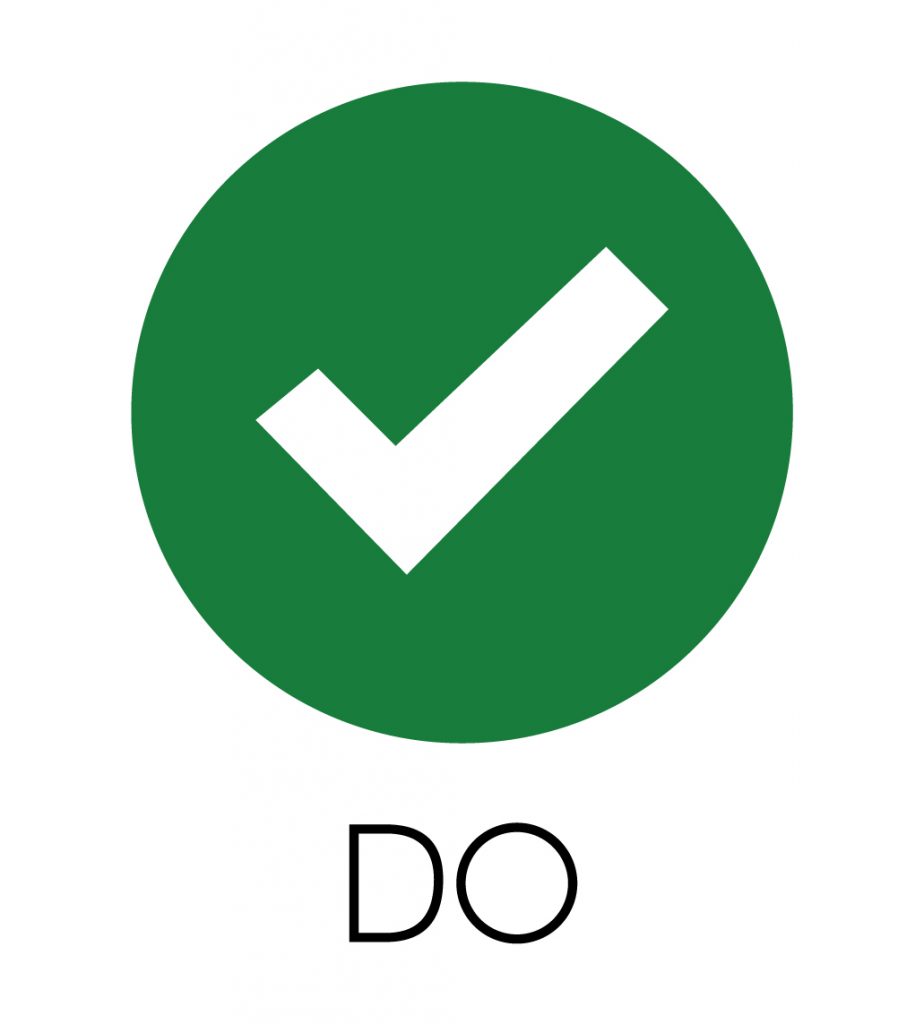
Do: Teach your dog to be comfortable wearing a muzzle using rewards and lots of patience. This will help a dog to relax while wearing the muzzle and not struggle so much to get it off.
Do: Make sure that your dog’s muzzle fits properly and is secure. If your dog will be wearing the muzzle for more than a few minutes, make sure it allows a dog to open his or her mouth to pant.
Do: Use the muzzle as a safety aid for your dog’s fear or aggression training program. Working with a well qualified, positive trainer is the best way to go!

Don’t: Use a muzzle to “fix” a fear or aggression problem. Using the muzzle this way could make the aggression worse. Teaching your dog to be comfortable around what he/she is upset about by using positive training while using a muzzle as a safety measure is the most effective way to help your dog.
Don’t: Leave a muzzle on your dog while unattended. Your dog could scratch at it trying to get it off and injure himself.
Don’t: Trust a muzzle completely, as a dog can be amazing Houdini at the most inopportune moments! A back up plan such as a leash is always a good idea.
Don’t: Use a muzzle as a replacement for a crate and other prevention methods to stop destructive chewing when you are not there to supervise. This could result in your dog injuring himself trying to get the muzzle off or in other behavioral problems due to frustration.
Don’t: Use a muzzle as a way to get dogs to stop fighting with each other. Dogs can still fight while muzzled and injure themselves. So muzzling can make the fighting issue worse. It’s best to use a muzzle as a safety measure together with positive training methods to teach your dogs to like each other.
Don’t: Use a tube or grooming style muzzle that restricts your dog from panting for more than a few minutes at a time. Dogs can overheat very easily. A better option, is a basket-type muzzle.
Don’t: Muzzle your dog for off-leash play unless you are preventing her from eating objects and are using it as a safety back up for that. If your dog has a fear or aggression problem, a muzzle can be a helpful safety measure, but you should also keep your dog leashed so that you can supervise interactions.
Don’t: Use a muzzle on an unsupervised dog to stop a barking problem. Most likely if your dog is barking while you are away he is either anxious or bored and the problem would be best solved using positive training methods to help your dog be comfortable alone or by providing more exercise or puzzle toys and chew toys. Muzzling a barking dog while unattended could cause the issue to become worse or your dog could injure him or herself by trying to remove the muzzle (for more information, please check the article “Dog Muzzle Safety Guide. How to Best Use Muzzles with Your Dog” ).
Now when you know basic things and know how to turn an ordinary muzzle into a true friend to your dog, I think we can go through frequently asked questions that may arise when a muzzle becomes a part of your training and walking kit. Here you can find complete answers if you haven’t found them in the text above.
F.A.Q.
1. Can my dog eat/ drink in a muzzle?
I’d like to say “yes”, but mostly it depends on the model of a muzzle. Most muzzles are produced with a gap which let you feed or give water to drink. Many of them also come in a transparent design, so you can easily see how your dog is feeling through his/her facial expressions.
But please note that it is impossible with the occlusion type of muzzles as they tend to shut the mouth of a dog. So, it’s impossible to feed a dog through it, give him or her water, as well as to pant, so it’s just the best solution only for visiting vet or groomer.
2. Is it safe to leave a dog with a muzzle on for a long time?
No, please never use a muzzle for an extended period of time. Despite there are some models that state to be used for a whole day, please don’t forget that in any case your dog is a living and breathing organism and so your pet has to make the most of his or her snouts.
Keeping a muzzle for hours can expose your dog to bacterial accumulation since they will be poking that muzzle in places where these are present. Besides, they can lead your dog to feel frustrated and annoyed either due to the weight or unnatural presence of the muzzle in the mouth.
If you use a muzzle of occlusion type please remember that it tends to restrict a dog’s ability to pant or breathe heavily which is how he/she cool off his/her body. As a result – your dog will eventually overheat if a muzzle is left on for an extended period of time. These are recommended only for short-term needs for 5-10 minutes when visiting vet or groomer. Remove the muzzle immediately after the procedure. A muzzle with a basket allows panting and can be worn for longer periods, as walking in some public places or training.
3. Сan I put a muzzle on and let my dog walk unattended?
Never leave a dog unattended if he/she has a muzzle on. And please believe me there are several reasons why you should never do this. Firstly, it can get tangled and put your dog at risk. Secondly, it can accidentally restrict your dog’s breathing by tightening up on the snout. Thirdly, your dog may try to get the muzzle off and scratch his/her face seriously or break nails. Fourthly, (it refers to occlusion muzzles) your dog will overheat because he/she cannot pant.
4. Which muzzle is better? Leather or wire cage?
A wire dog muzzle provides your pet with better airflow. It allows him/her to drink water and pant while being muzzled. On the other hand, a leather muzzle is a better solution for winter and cold weather, it does not reflect sunlight and is usually more lightweight in comparison with wire cage muzzles. Both kinds of muzzles are easily adjustable.
5. Can my dog be allergic to some materials the muzzle is made of?
Yes, please pay attention to the material which is used for production, as some dogs have a known allergy to some stuff. You can notice it because of unusual behavior of your dog or some external symptoms: red, scrabbed skin, itchy skin or itchy ears and so on. So if you have noticed it – try to determine the cause of allergia, maybe it’s really a muzzle, ask the vet about solution and treatment and chose a muzzle made from other materials.
If your dog is allergic to some synthetic materials, it is better to chose muzzles that are made of fabric or leather, usually they are elegant, quite safe and very comfortable on the skin of your dog.
6. Is it physically and psychologically painful for a dog to wear a muzzle?
If you’ve chosen the muzzle of appropriate size and model, it’s not. But there are some points you should remember: don’t try to put a muzzle on dog forcefully for the first time. On the one hand, it can traumatize your dog, and on the other – it can have serious consequences such as aggression towards other people who try to touch his/her mouth. Emotionally, this is not good for dogs and it can scare them for life.
So please train your dog to get used to a muzzle before actually using it. Positive reinforcement has proven successful in solving many behavior problems and it is the best method to make your dog love the muzzle.
Maybe I’m repeating myself, so sorry for that, but better to prevent it in advance: always take into account time and your dog’s temperature when you use occlusion types of muzzles, as they restrict the ability of your dog to pant. So put it not more than for 5-10 minutes.
7. Can I modify my muzzle to create the most comfortable fitting for my dog?
Yes, you can. Sometimes, in view of some reasons, it can be quite difficult to find a muzzle that fits your dog ideally, so you can make some modifications in your muzzle that help prevent skin chafing, provide more secure fit or ensure more efficient delivery of treats.
For some dog owners purchasing a new muzzle can be quite an expensive charge. But there is no problem if you don’t buy it but make with your hands using makeshift materials. There are a lot of videos about it in the Internet, so there won’t be any problems with it.
8. Will a muzzle help if I have an aggressive dog?
Never use muzzles as a “treatment” for dog anxiety or dog aggression. Dogs who have behavioral problems such as aggressiveness and anxiety should always be trained and treated properly. A dog muzzle is not a type of treatment for these problems as your dog will remain and act the same especially when the muzzle accidentally breaks or loosens. Find a professional dog trainer or behaviorist in order to address problems like these.
A muzzle can be used just as primary equipment if you need to go out for walking or to the public place. If you know that your dog has a higher tendency to become aggressive he or she should be fitted with a more durable muzzle in order to maintain safety for you and other people around.
9. Is your dog a bad dog if he is wearing a muzzle?
Please forget about this statement! If you care of your dog and people around, you should think and prepare in advance. Even if your dog is obedient and loves everybody and everything around, don’t forget that he/she is an animal and in some unpredictable situation he/she can be aggressive and even can bite someone. Being a responsible owner means protecting people from your dog. In situations where your pet may feel anxious, stressful or nervous, a dog muzzle is a solution to prevent the unwanted consequence.
10. Do all muzzles match all dogs?
I think I should not talk here about sizes, types and designs. The muzzle that you chose for your dog must match perfectly. I think it’s clear. But here I’d like to pay your attention to the other point – material that muzzles are produced from. So, if your dog is kind and polite you can chose the muzzle from some weaker materials, as rubber or plastic baskets. But if you know that your pet is tend to aggression, chose the muzzle that not so easy to break, like metal baskets. They are also studier in case your dog tries to smash it against a wall or on the floor.
And of course, you know pretty well that the breed of a dog is the factor to consider as well. You can not buy a muzzle for training, designed for a medium and large breed if you have, for example, a French Bulldog, and vice versa.
11. Can I use a muzzle to stop my dog barking?
Do not use a muzzle to stop your dog barking. It is not a solution and it will be accepted like a torment for your dog. There are methods to stop excessive barking of your dog, and you should practice them instead.
11. What is the best muzzle for dog transportation and traveling?
I recommend using the same dog muzzle models for dog transportation as for the vet visit. Such a muzzle should have enough free space for your dog to pant and breathe. Good air circulation is also extremely important for this purpose. Be aware that you must keep your dog always muzzled during the transportation procedure. A dog may be stressed in these situations and his/her behavior can become unpredictable. So the muzzle is a must-have attribute. But please firstly make sure that your pet got used to wearing a muzzle in order not to feel discomfort during transportation. For some dogs even the fact of transportation is quite stressful.
12. Can a dog swim with a muzzle on?
Swimming demands complete air flow. A muzzle should be water resistant to stand corrosion after water contact. You can choose activities wire cage muzzles for water activities because they correspond to these needs. Just don’t leave your dog alone while swimming. Remember you are responsible for your pet’s comfort, health and life.
13. Are there adjustable dog muzzles that fit puppies?
It will be great if you manage to get a supply which can be adjusted as long as your canine grows. This option depends on the design of the muzzle. Usually, metal muzzles have fixed shape wire cages and adjustable straps as well as some leather ones. Also, there are leather muzzles that allow to adjust the part which covers your dog’s snout. But if you want to provide your dog with maximum level of comfort or if you need to buy a muzzle for a certain purpose, you will probably have to purchase several muzzles until your puppy becomes a fully grown dog. It means big expenses, but it will be better than saving money on your dog’s well-being. Also, remember that it is not recommended to buy muzzles for small puppies.
So, my dear friends, we reached the logical conclusion of our long, but also exciting story about muzzles. I hope I was really good at this storytelling and the information will be quite helpful and useful.
And one more important thing just at the very end of my story:
A muzzle is really a necessary piece of equipment for every dog owner. It’s really a good solution when you take a dog to the public places, go to the vet or groomer or want to get him/her acquainted with new pets, neighbors. A muzzle on your dog gives some peace and quiet to an owner and people around. With proper training your four-legged friend will feel quite good with a muzzle on and will love it.
There is really a wide variety of muzzles on the market, so there will be no problems in choosing an appropriate model and type for your dog. I hope my article will be your guiding star on your way through the rough of the World Wide Web.
Be polite and patient with your pooch! Use training with delicious food treats and soon wearing a muzzle will be an interesting and funny game. To your success!




